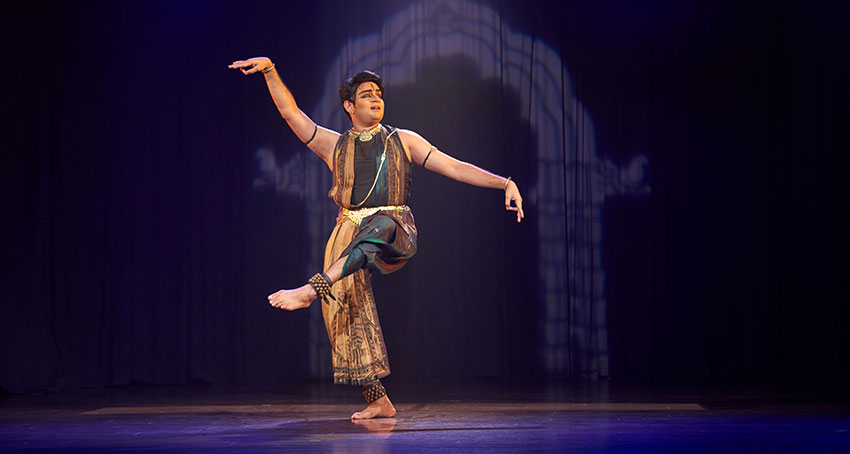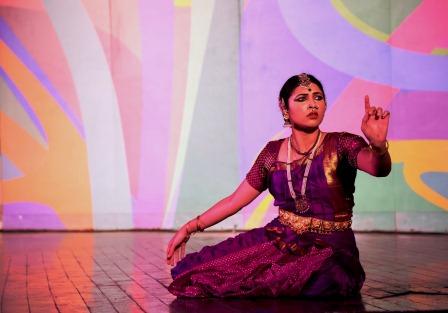Nisha Nair’s conversation with the renowned Art Consultant, Dr. Usha Rk for ClassicalClaps, can turn into a full-blown experience where you can feel her passion for dance and other forms of art pour forth in an all-encountering embrace. Usha Rk has been a mastermind behind path-breaking art, dance and music festivals in our country where she has worked with legendary artists.
She is a former Member Secretary of UNESCO’s Intangible Cultural Heritage, Ministry of Culture, India and the persona behind the nominations that led to the inscription of the venerated Indian city of Varanasi as a creative city of music, the discipline of Yoga and the incredible Indian congregation of Kumbh Mela into the UNESCO’s Representative List of Intangible Cultural Heritage.
Through a free-wheeling chat, Usha takes us through an interesting journey of her life where art and dance have played the dominant roles. First, she extols the role of struggles in her life as a dancer and the Guru-Shishya Parampara as a system. “Being a good artist is not a mathematical formula”, she says. “It’s a walk of life and the love for dance will take you to greater heights”.
Her strategy is simple:
“Good training, thorough practice and discipline are very important. Along with that, one should also have tremendous passion, utmost humility and the right attitude. You have to love the art form and have to respect it. These six key words are very intrinsic for a good performer and a good artist.”
Trained in Bharatanatyam and Kuchipudi, Usha often wonders at the extension of Guru-Shishya Parampara of teaching in the modern day and age and is of the opinion that, with the increasing number of student-teacher ratio, the proposition of having a one-on-one learning opportunity is slowly vanishing. “Guru-Shishya Parampara is not just about taking lessons from the Guru in an informal school. It is about the intimate atmosphere in which, a student has the privilege to not only learn the art form, but also have a deep understanding of the art form as a philosophy in life. In today’s urban scenario, where around 300 students are learning from one teacher, do you think it will ever be possible for a student to learn the dance form through other enriching ways like sharing of anecdotes by the Guru or discussing details about ragas, talas etc. through casual story-telling sessions?”
She is not against formal education and getting a certificate in the Classical art forms. But she staunchly thinks that learning any Classical art form is about embracing a whole new world of philosophy of life, day-to-day discipline, dedication and hard work.
Usha emphasizes, “The journey of Indian Classical Dance is like a hurdle race where one hurdle is bigger and more difficult than the previous one; And this applies to a performer, an organiser or presenter or a teacher in the same way. It is very difficult because the field itself is very small compared to the rest of the world.”
Usha stands quite firm on her views regarding shaping up to be a performer of any Indian Classical Dance form. “To be a performer, you have to practice at least 10-12 hours a day. Becoming a teacher, unfortunately, takes away that privilege from a dancer,” she says.
She had come to Nalanda Nritya Kala Mahavidyalaya, Mumbai, a dance institution run by Padmabhushan Kanak Rele to take a two-day workshop on “Thematic Presentations – From Thought to Performance”, where she explained how a thought or an idea can be led diligently to a stage performance.

“I was explaining to the students in the workshop that in the lifespan of a dancer, maybe from 20 to 70 years, what may be deemed the “peak” period in the dancer’s performing career is the age between 25-45. On the other hand, music follows a completely different trajectory where age is not a barrier or the measuring rod. Musicians usually have a stable performing career until they become an octogenarian. In dance, the emphasis on health, physical beauty and the retention of energy are key factors.
If you are a regular performer, the best age of maturity and fulfilment in terms of a performing career spans from about 30 to 45.
However, that is also the age when Indian men and women get married and usually get bogged down by responsibilities. In that process, health, regular sadhana and energy of the dancer gets marginally affected,” she quips. She also cites danseuse Malavika Sarukkai, one of the very few and finest dancers who have managed to perform on stage till now. “A few do manage well till a ripe age but with a lot of hard work and time that they put towards maintaining a healthy body,” informs Usha.
Moving ahead, she speaks about the sad state of funding for Indian Classical Dance forms in our country. “So there is this huge space which is covered by cinema, there’s another space which is covered by music and then there is some space covered by folk, tribal, martial art forms and then there is a small space for the classical forms which entails an even smaller allocation of funds from the government and corporate sectors alike. At times, when they allocate some funds, it is shamefully minuscule and not enough to cover the entire map of Indian Classical Dancers and dance forms throughout the country. So, performers end up becoming teachers because that is the only source of regular and steady income for them!”, Usha reiterates the situation unabashedly.
She points out that the vital reason behind the drying up of funds is because, these days, Corporate Social Responsibility Funds are directed more on a priority basis towards issues related to the environment like plastics, rivers, pollution, deforestation etc. According to her, Indian Classical dance sinks to the bottom of the priority list in the process. She, however, puts forward without a hint of hesitation that the Government has sufficient funds but is unwilling to allocate it to artists who do not network well and often with the officials who are in charge of such allocation. She points out that the government also ends up allocating funds sometimes to the undeserving artists out of sheer ignorance of the art form on the part of the lower end of the bureaucratic spectrum. “The challenge has become gargantuan now with no corporate support, I would say,” says Usha.
Apart from being a dancer, Usha’s artistic vista expands to being an art consultant and critic too for over three decades.
[adrotate group=”9″]
Next, she brings into force, her self-driven responsibility for creating next-generation superstars in a gamut which is full of logistical hurdles. Usha Rk opted out of the corporate world and went back to her first love and passion – dance when she felt a strong calling. Her tireless efforts of consistently presenting young and upcoming talents on stage have given fine dancers like Sathyanarayana Raju, Soundarya Srivatsa, Mithun Shyam, Parshwanath, Dakshina Vaidyanathan Baghel, Arundhati Patwardhan amongst many others ensured, huge visibility. Organizing such shows sometimes becomes a sharp pocket-pinch considering the funding and sponsorship scenario where Usha is left with no other option but to spend money from her own savings and sometimes, rely on a benevolent friend or acquaintance who is ready to give his auditorium or some such collateral for free. Most of the time, after paying for the artists’ travel and accommodation, it becomes a steep proposition to pay the artist his/her fees. In such cases, she ensures every time that every artist is treated with dignity and respect and goes back with good memories of the show. Working as an art consultant in the field of Classical Dance, she thinks, is anything but lucrative.
“I don’t earn anything out of it, rather end up spending most of my savings. But it keeps my passion fired.”
Usha has an interesting an evolved modus-operandi with regard to promoting artists, which is very akin to the way artist management agencies function in the Western countries. She curates about 6-8 dancers only whom she keeps promoting through performances over a period of 2 years to increase their visibility vis-a-vis polishing their stage performance sensibilities. Under her aegis, artists and performances are packaged into interesting concepts with a rich blend of traditional repertoire and specific ideas to cater to the audience. This change, she believes strongly, can bring in a lot of difference in the image of an artist and also augment the growth of the performer.
Talking of government, she veers towards the positives and negatives of working in a government set-up at the Intangible Cultural Heritage, Ministry of Culture. “Things move at their own sweet pace in such a set-up and often get delayed; However, I carry a lot of good memories of the straightforward approach that they had to work and their appreciation for the way I work,” she reminisces. Usha worked on 5 projects within a span of two years out of which, 4 already have acquired nominations and inscription and the 5th one remains in the pipeline, ready to be inscribed any day. Despite this huge turn-around, Usha decided to come back to Classical Dance and the promotion of talented dancers because of her commitment towards doing something meaningful for the next generation of artists of our country who deserve a name for their talent.
Creating opportunities becomes a crucial factor in a field where nepotism touches its optimum. Usha says that nepotism is a mundane human nature which, sadly, does not have any solution other than self-realisation.
“Nepotism nahi hona chahiye. Sab log samaan hone chahiye. Sab dancers ek jaise hone chahiye humare liye. Lekin wo nahi hai na. Wo human nature hai.”
Despite treading a path filled with transformational hurdles every day, Usha Rk remains firm in her stance that it is talent that wins in the end. This is a belief she adheres to with all her life because, at the end of the day, she points out, an artist has to keep the audience engrossed for at least 2 hours with his/her performance. “That takes a high amount of calibre which, going the easy way tainted in nepotism doesn’t help. With nepotism, you will get a quick and easy opportunity to climb on the stage. But what brings you back to that stage is your consistency as a good performer; Here, no neta nor any influential person or high-ranking official will help you. The journey to stardom is a starkly honest and lonely one,” she signs off.
*All pictures provided by Dr. Usha Rk
[adrotate group=”9″]











1 thought on “The journey of Classical Dance is like a hurdle race – Usha Rk”
Excellent journey!!!